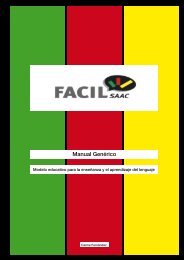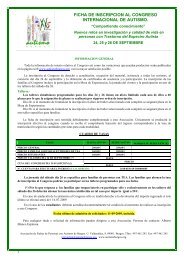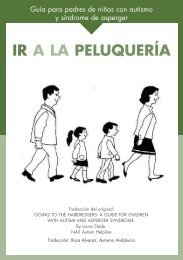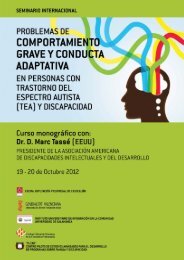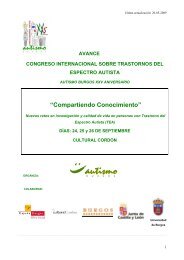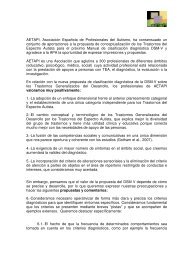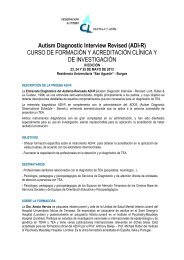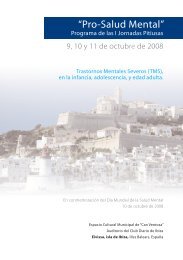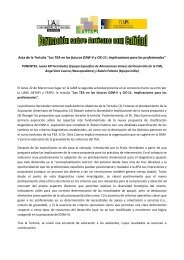persons with autism spectrum disorders - Aetapi
persons with autism spectrum disorders - Aetapi
persons with autism spectrum disorders - Aetapi
Create successful ePaper yourself
Turn your PDF publications into a flip-book with our unique Google optimized e-Paper software.
Persons <strong>with</strong> Autism Spectrum Disorders<br />
Although not universally accepted, the diagnostic labels of “Autism”<br />
and “Pervasive Developmental Disorders” are being progressively<br />
substituted by the term “Autism Spectrum Disorders” (ASD) to stress<br />
two points: one, that we refer to specific <strong>disorders</strong> of social development,<br />
and, two, that there is a marked heterogeneity in the presentation<br />
of ASD, ranging from the full clinical picture to partial expression<br />
or individual traits that are related to ASD but do not merit clinical<br />
diagnosis.<br />
In considering the latest DSM IV TR classification manual, the ASD<br />
concept does not include Rett’s Disorder, but includes Autistic Disorder,<br />
Asperger’s Disorder, Childhood Disintegrative Disorder and Pervasive<br />
Developmental Disorder Not Otherwise Specified (Atypical Autism).<br />
It is likely that future revisions of classification systems (e.g. DSM V,<br />
expected in 2012 from the American Psychiatric Association) will<br />
modify the present classification and diagnostic criteria for all psychiatric<br />
conditions. This will probably involve the consideration of both<br />
dimensional and categorical approaches to diagnosis, greater focus<br />
on developmental aspects and information derived from neurobiological<br />
and genetic sources, together <strong>with</strong> more detailed assessment<br />
of comorbid conditions. The World Health Organisation has<br />
also begun an ambitious review of its current classification system<br />
(ICD), aiming to submit the final version for approval by the World<br />
Health Assembly in 2014.<br />
Despite the uncertainty of the future diagnostic criteria, which will<br />
have a key role in establishing the frequency of these <strong>disorders</strong>, there<br />
is now converging evidence that, using current diagnostic criteria,<br />
many more individuals, in many different countries are being diagnosed<br />
<strong>with</strong> ASD. Rigorous surveys from North America found that<br />
about 1 in 150 8-year-old children in multiple areas of the United<br />
Sates had an ASD. Epidemiological studies from Europe point to a<br />
similar figure among children (0,9 per 150, or 60 per 10.000). There are<br />
no empirical data on the frequency of ASD among adult populations,<br />
although there are on-going studies to clarify this important question.<br />
The over-representation of males (four to one) is confirmed, as well as<br />
the presence of ASD in all social classes and different cultures.<br />
CLINICAL PRESENTATION<br />
The clinical expression of <strong>autism</strong> varies greatly, not only between<br />
different individuals but also <strong>with</strong>in the same individual over time.<br />
The diagnostic term ASD is<br />
now substituting “Autism”<br />
and “Pervasive Development<br />
Disorder” in order to stress:<br />
1) specific <strong>disorders</strong> of social<br />
development, and 2) the great<br />
variety in individual symptoms.<br />
The latest DSM IV TR<br />
classification manual describes<br />
<strong>disorders</strong> found <strong>with</strong>in the<br />
range of ASD.<br />
Future revisions of classification<br />
systems will modify the present<br />
classification and diagnostic<br />
criteria for all psychiatric<br />
conditions on the basis of new<br />
research data from diverse<br />
sources.<br />
The WHO is also reviewing its<br />
classification system (ICD). This<br />
should be finalized in 2014.<br />
Using current diagnostic<br />
criteria, there is evidence that<br />
many more children are being<br />
diagnosed <strong>with</strong> ASD (1 in<br />
150). Figures for adults <strong>with</strong><br />
ASD are not yet available. It is<br />
confirmed that ASD is present<br />
in more boys than girls (4 to 1),<br />
and that it occurs in all social<br />
classes and different cultures.<br />
Within the <strong>autism</strong> <strong>spectrum</strong>,<br />
features of behaviour vary<br />
greatly from individual to<br />
individual and also <strong>with</strong>in the<br />
same individual over time.<br />
3



